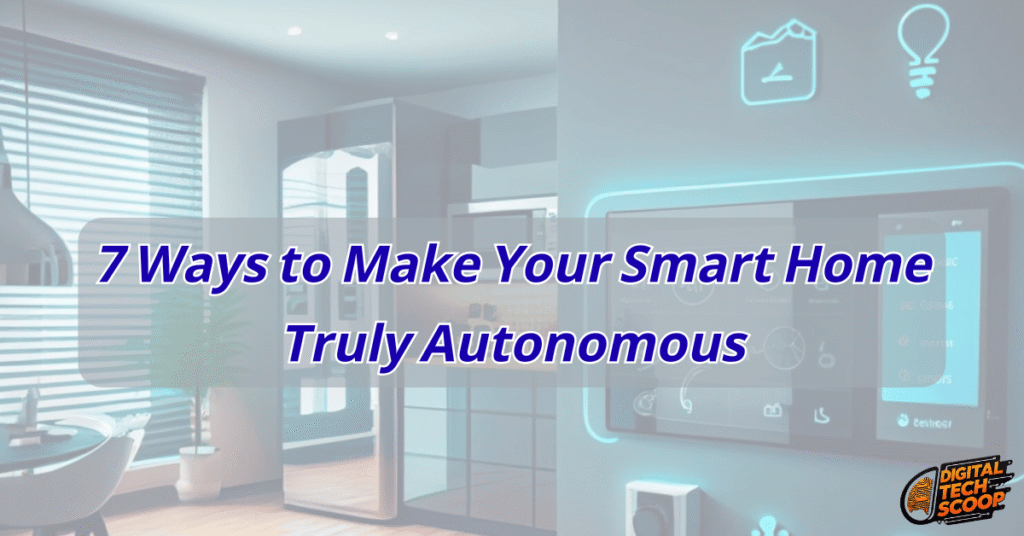
Smart Home technology has come a long way from simple voice assistants and connected light bulbs. In 2025, innovation is focused on making your Smart Home not just connected, but autonomous. Instead of you constantly managing devices, your home can now predict your needs, optimize energy use, and provide security—all without much input from you.
If you’ve ever wanted your home to truly think for itself, this guide explores seven practical ways to make your Smart Home more intelligent, seamless, and self-sufficient.
Table of Contents
Toggle1. AI-Powered Home Assistants That Anticipate Your Needs
The days of having to ask your voice assistant to change the lights or play music are now a thing of the past. By 2025, AI-powered smart home assistants will be able to recognize your habits and anticipate your needs.
- Get up at seven in the morning? The coffee maker, thermostat, and curtains can all be operated automatically by your helper.
- Leave every day at 9 a.m. for work? The system can activate the security system and switch off unused gadgets.
Your Smart Home becomes proactive rather than reactive by using AI, resulting in a customized space that changes to suit you.
2. Advanced Energy Management Systems
Sustainability is one of the biggest priorities in modern living, and Smart Home technology is helping lead the way. Energy management systems in 2025 can:
Automatically shift appliance use to off-peak hours to save costs.
Optimize heating and cooling based on weather forecasts.
Store renewable energy from solar panels in home batteries for later use.
This level of autonomy doesn’t just save you money; it reduces your carbon footprint without you lifting a finger.
3. Autonomous Security and Surveillance
A genuinely self-sufficient smart home needs to safeguard both its residents and itself. AI and machine learning fuel today’s security systems. These systems can do the following in place of continuously sounding an alarm for every tiny movement:
- Distinguish between an invader, a pet, and a family member.
- Automatically lock windows and doors if you notice any strange behavior.
- Only when a significant event occurs will you receive real-time updates on your phone.
Your house becomes its own protector with features like motion tracking, facial recognition, and predictive monitoring.
4. Smart Kitchens with Automated Cooking
In 2025, Smart Homes are making meal preparation easier than ever. Imagine a kitchen that plans your meals, orders groceries, and even cooks.
Smart fridges can track inventory and notify you when items are running low.
Ovens can automatically adjust cooking times and temperatures based on the recipe.
AI meal planners integrate with your diet preferences and health goals.
This not only saves time but ensures healthier eating with minimal effort.
5. Robotic Assistance for Daily Chores
Robotics have become a central part of Smart Home automation. Beyond robotic vacuums, you can now have:
Window-cleaning robots that keep your glass spotless.
Lawn-mowing robots that maintain your yard.
Smart laundry systems that wash, dry, and fold clothes.
By automating chores, you reclaim valuable time while your home keeps itself in order.
6. Personalized Health Monitoring
By 2025, smart homes will be more health-conscious than ever before. Your surroundings can adapt to promote your well-being thanks to integrated health sensors and linked wearable technology.
- When contaminants increase, air purifiers turn on automatically.
- Your sleep is tracked by smart beds, which also modify comfort levels.
- Medical professionals can be alerted by health monitoring gadgets that identify abnormal heartbeats or sleep apnea.
With this degree of connection, your smart home becomes an active partner in your health.
7. Interconnected Ecosystems for Seamless Living
The future of Smart Home autonomy lies in ecosystem integration. Instead of juggling multiple apps for different devices, everything now works together.
Your electric car communicates with your home’s energy system to optimize charging.
Lights, climate, and entertainment sync automatically when you enter a room.
Cross-device AI ensures that preferences follow you across every space.
The result is a living environment that feels seamless, intuitive, and fully customized.
Final Thoughts
By 2025, having a smart home means more than just convenience; it means building an autonomous ecosystem that enhances your quality of life. Making your Smart Home self-sufficient is now simpler than ever thanks to AI-powered assistants, robotic assistance, and energy-saving technologies.
Not only is the future of living linked, but it is also proactive, intelligent, and made to relieve you of the menial chores that once consumed your days. You may make your home a really self-sufficient Smart Home that serves you rather than the other way around by adopting these seven strategies.
FAQs
An autonomous Smart Home doesn’t just respond to commands—it predicts needs, learns behaviors, and acts independently to improve comfort, security, and efficiency.
Modern Smart Homes use encrypted networks, biometric authentication, and AI-driven monitoring to ensure maximum protection against cyber threats.
Yes, through energy management, efficient appliance use, and predictive maintenance, Smart Homes can significantly reduce monthly bills.


